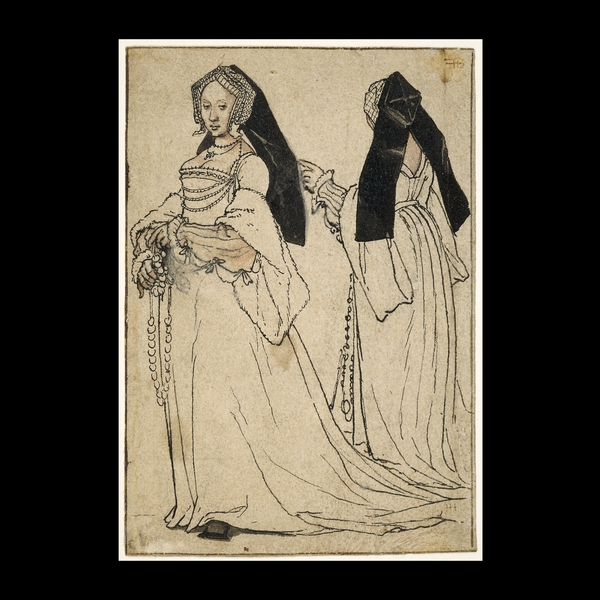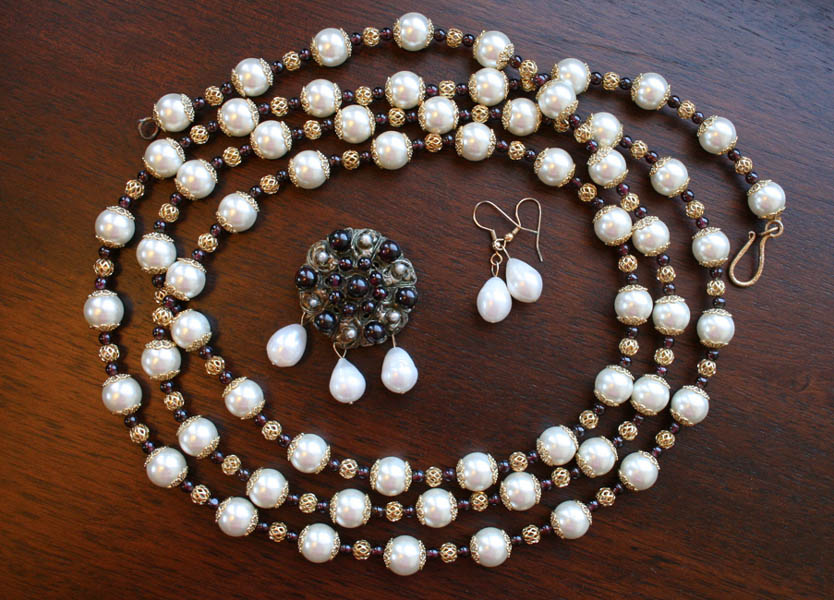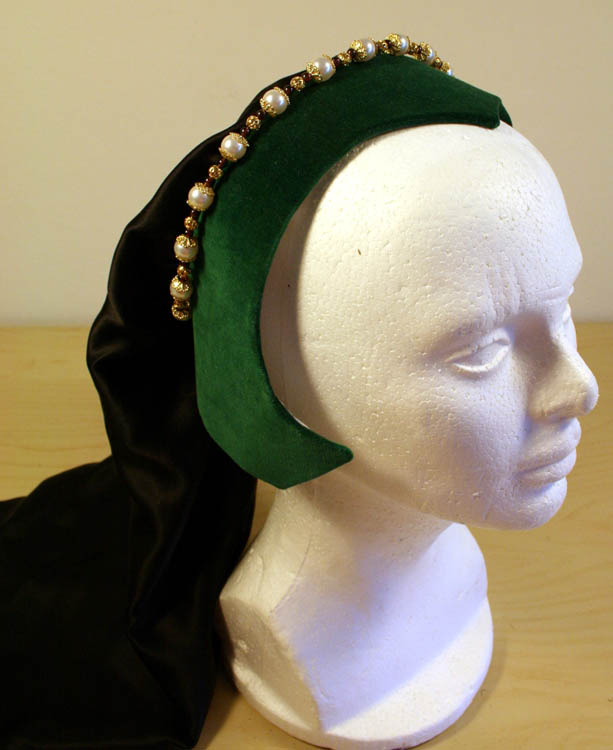
December 2005 – July 2007
A Tudor gown, inspired by the famous Holbein sketch. Before going into more detail about the project, I’ll start with the good stuff. 1) I really like all the sleeves and jewelry, 2) the green came out the shade I was hoping for, and 3) I actually finished it! Now for the less than good….

The British Museum
This began with a grandiose plan. I was even working on a strip of blackwork for a smock. However as the project progressed, I came to realize that I had made a very critical mistake: a crummy fabric choice. Its a low-quality velveteen that I’d dyed with Rit. Honestly, the pile already looks threadbare, and the costume hasn’t even made it to an event! Since I didn’t want to risk having icky green dye come off on a fancy embroidered smock, I made a simpler smock in some cheaper linen.
Fabric aside, the least successful part of this costume has been cleverly hidden from sight, via bad lighting, and my own arms: the placard (a center panel pinned to the front bodice). It doesn’t sit right at the waistline, and the boning shows terribly to boot.
On the other hand, there was massive amounts of patterning required for this costume, so it was a good learning experience. My bodice pattern was achieved with the duct tape and t-shirt method (tape yourself over a corset). It may seem counter-intuitive that a three dimensional taped body form could just be flattened out and cut into a pattern. But I have to say it worked pretty well! In my first attempt at drafting the shoulder straps I did as I’d done for the Venetian: cut them on the straight grain. It didn’t work at all. So I ended up using the method in Hunnisett’s book for try number two — straps attached at the back bodice, coming up over the shoulders on the bias. I had to piece my bodice at the shoulder seams to do this. To my surprise and delight, the center back “v” can be cut quite low, and the front neckline made very open, yet the huge heavy sleeves still don’t pull the bodice off the shoulder point.
I suspected the Holbein sketch could best be reproduced with a gored skirt, but decided to give the Hunnisett pattern a try anyway. However, there was far more fabric at the waistline than could realistically be gathered into the 6 to 8 back pleats you see in the sketch. So the side panels of the skirt are gored. There’s a fairly substantial bum roll basted to the inside of the skirt, and the only other undergarment for this costume, besides a shift, is my hard-working corded petticoat.
I drafted the under sleeves, and hand-sewed all the tucks. They’re in a gorgeous silk brocade with a tube of linen sewn in. The over sleeves are straight out of Hunnisett’s text and made from my mountain of black velveteen (a much nicer fabric than the green).
As for the jewelry, the recycled brooch has garnets, mini pearls and large freshwater pearl drops. The girdle is garnets, large glass pearls and gold filigree from Michaels. An onyx necklace is not shown. The earrings took a bit longer as I was having a difficult time finding pearl drops at the local bead stores. Eventually I was able to pick these up at a craft fair from a very nice jeweler who sold them to me out of her stash. The gown is trimmed with the same beads and stones.




Gable Hood (June – July 2006)
I made a gable hood to go with this outfit. (The Tudor Tailor pattern was free on Ninya Mikhaila’s website before her book was released). The only modification I made was to widen the opening around the face (I angled out the undercap very slightly).
The lappet’s fabric matches the gown’s undersleeves, and the black box and veil are in silk charmeuse. The gold crisscross is a polyester couching cord. It’s really too shiny for my taste. But it was all I could come up with at the time. The hood is fully lined in fine linen and decorated with glass pearls and gold filigree.
Since my hair isn’t thick enough to wear as a support for the hood, I made a little rectangular pillow. You can see it sitting on top of the styrofoam head. This pillow distributes the weight of the hood. It also helps cushion my forehead from the undercap’s sharp front edge.
Unfortunately, I never ended up wearing this headdress. In fact, I decided it looked terrible on me! I think I got the proportions wrong. At one point I brought it to a costumer’s swap-and-sell, thinking I’d find it a new home. Interestingly, it looked really nice on those who tried it. I was somewhat consoled by this, and decided that the project wasn’t a total failure. So, I’m just holding onto it. Once The Tudor Tailor became available, I made up the french hood instead.




